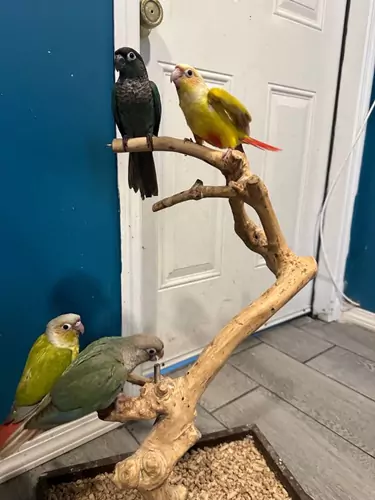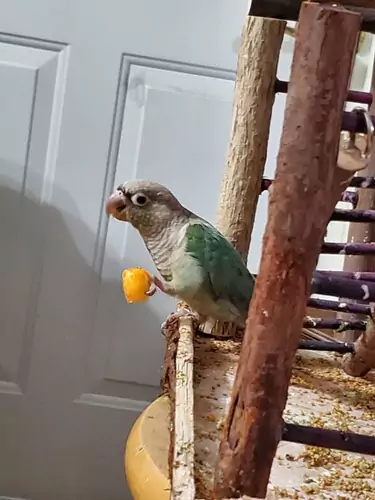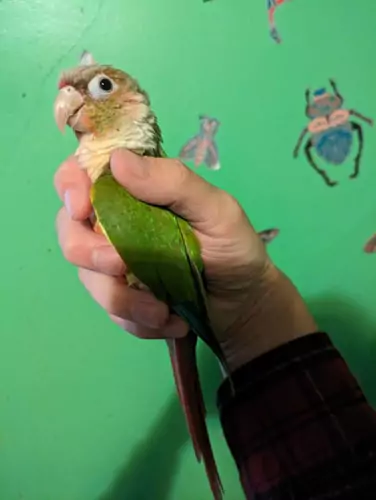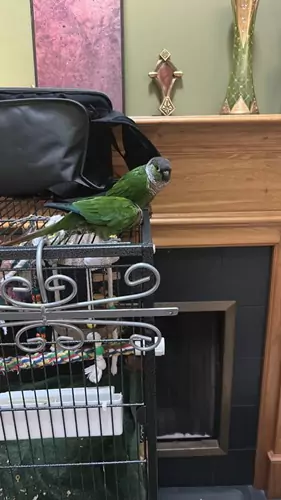You love your green cheek conure and want to ensure they live a long and healthy life. The average lifespan of a green cheek conure in captivity is 10 to 15 years, but did you know that with proper care and attention, some have been known to live up to 20 years or more? That’s why it’s important for you as an owner to understand the factors that can influence their lifespan, including diet, exercise, and genetics. By providing your green cheek conure with a balanced diet, regular exercise, and routine veterinary check-ups, you can help ensure they have the best chance at a long and happy life. Additionally, female conures, blue crown conures, sun conures, and cheeked parakeets also require similar care to maintain their health and longevity.
Average Lifespan of Green-Cheeked Conures: How Long Do They Live?

If you are a bird lover, you might be curious about the lifespan of your pet Green-Cheeked Conure. These parrots are known for their playful and affectionate nature, making them good pets for those who love exotic pets like parakeets. But how long do they live? In this article, we will discuss the average lifespan of Green-Cheeked Conures and what factors can affect their life expectancy.
Life Expectancy of Green-Cheeked Conures
The average life expectancy of Green-Cheeked Conures, a type of parakeet, is around 10 to 15 years. However, with proper care and nutrition, these exotic pets have the potential to live up to 20 years or more, making them a great choice as long-term family pets. This means that if you provide your parrots with a healthy diet and regular veterinary check-ups, they could potentially be with you for two decades!
Factors Affecting Life Expectancy
Several factors can affect the lifespan of a Green-Cheeked Conure, as well as other conures such as Blue Crown Conures, Sun Conures, and female conures. Genetics plays a role in determining how long your bird will live. Some birds may have genetic predispositions to certain health conditions that could affect their longevity. It is important to note that these factors also apply to other parakeet species.
The environment also plays a significant role in the lifespan of these birds, including green-cheeked conures, sun conures, and blue-crown conure parrots. Female conures, in particular, may be more susceptible to health problems if they are exposed to toxins or other harmful substances. Similarly, if they are kept in cramped or unsanitary living conditions, it could lead to a reduced lifespan for these birds.
Diet is another crucial factor affecting the lifespan of these birds, including green-cheeked conures, sun conures, cheeked parakeets, and blue-crown conure parrots. It’s important to provide them with a balanced diet that includes fresh fruits, vegetables, and high-quality pellets. A poor diet lacking essential nutrients can lead to various health issues such as obesity or malnutrition which can shorten their lifespan.
Prolonging Your Bird’s Lifespan
To prolong your bird’s lifespan, there are several things you can do, especially if you own green-cheeked conures, sun conures, or cheeked parakeets. These birds, including green cheek conures, require specific care to maintain their health and well-being.
Provide green-cheeked conures, sun conures, green cheek conures, and blue crown conure parrots with a healthy diet that meets their nutritional needs.
Keep their environment clean and free of toxins.
Schedule regular veterinary check-ups for your green-cheeked conures and sun conures to detect any potential health issues early on, as these species have a relatively long potential lifespan. Additionally, this is especially important for your cheeked parakeet.
Give your sun conures, green cheeked conures, cheeked parakeet, and blue crown conure parrots plenty of opportunities for exercise and mental stimulation.
Factors Affecting the Lifespan of Green-Cheeked Conures

Green-cheeked conures, also known as parakeets, are popular pets due to their playful and affectionate nature. However, owning a pet bird comes with a responsibility to provide them with proper care and attention. One important aspect of this is ensuring that they live a long and healthy life. In addition to green-cheeked conures, other parrots such as blue crowns and sun parakeets also require proper care to maintain their lifespan.
Stressful Living Conditions
Stressful living conditions can have a significant impact on the health and well-being of parrots, including green-cheeked conures and blue-crowned parakeets. These birds thrive in environments that mimic their natural habitat, which includes plenty of space to fly around, access to fresh air and sunlight, and opportunities for social interaction. Keeping them in cramped cages or isolating them from other birds can cause stress and anxiety, which may lead to health problems such as feather plucking, aggression, or even depression. It is important to note that providing proper care and environment can also increase their potential lifespan.
Lack of Proper Nutrition and Care
All parrots, including green-cheeked conures and blue crowns, require a balanced diet consisting of essential nutrients to maintain good health. Feeding them an improper diet can lead to malnutrition or obesity, both of which can contribute to a shorter lifespan. Neglecting their basic needs such as clean water, regular grooming, and exercise can also have negative effects on their overall health. Additionally, providing enough sun exposure is crucial for their well-being.
Exposure to Toxins and Pollutants
Green-cheeked conures, like other parrots, are sensitive creatures that can be easily affected by exposure to toxins or pollutants in their environment. This may include household chemicals such as cleaning agents or pesticides, cigarette smoke, or even fumes from non-stick cookware. These substances can damage their respiratory system or cause other serious health issues if not addressed promptly. The blue crown and sun conures share similar sensitivities and need to be protected from harmful substances as well.
Genetic Factors
While environmental factors play a big role in determining the lifespan of parrots such as green-cheeked conures, genetics also play a part. Some individuals may be predisposed to certain health conditions or have weaker immune systems, which can make them more susceptible to diseases and infections. It is important to choose a reputable breeder when purchasing a pet bird, whether it’s a blue crown or sun conure, to ensure that it comes from healthy stock.
Regular Veterinary Check-Ups
Regular veterinary check-ups are crucial for identifying and addressing potential health issues before they become serious, especially for parrots like the blue crown and sun conures. A qualified avian veterinarian can perform routine exams, blood tests, and other diagnostic procedures to monitor the health of your green-cheeked conure or other parrots. They can also provide advice on proper diet and care to help ensure that your bird lives a long and healthy life.
Care Guide for Ensuring a Healthy and Long Life for Green-Cheeked Conures

If you’re considering adopting a green-cheeked conure as a pet, it’s important to understand that providing proper care and attention is crucial for ensuring a healthy and long life for these affectionate parrots. Sun exposure is also important for their well-being, so make sure to provide ample opportunities for your feathered friend to soak up the sun. Here are some tips to help you give your sun-loving bird the best possible care.
Proper Diet
A balanced diet is essential for maintaining good health in pet birds, including green-cheeked conures, blue-crown conure parrots, and sun conures. In addition to high-quality pellets, fresh fruits and vegetables should be included in their diet. Avoid feeding them avocado, chocolate, caffeine, alcohol, or anything with high sugar content as these can be toxic to birds, including cheeked parakeets, and harm their health.
Regular Vet Visits
Just like humans need regular check-ups with doctors, pet birds such as green-cheeked conures, sun conures, and cheeked parakeets also need regular visits to an avian vet. This will help identify any potential health issues early on so they can be addressed before they become serious problems. Regular check-ups for your green cheek conure, sun conure, or cheeked parakeet could potentially save you from expensive vet fees in the long run.
Love and Attention
Green-cheeked conures, like other parrots, are social animals that thrive on love and attention from their human companions. Spend time playing with your bird daily in the sun by providing toys such as swings, ladders, bells, or chew toys which help them stay entertained while keeping them active mentally and physically.
Mental Stimulation
In addition to physical activities, green-cheeked conures require mental stimulation too. They are intelligent creatures that enjoy solving puzzles or learning new tricks such as mimicking sounds or words spoken by humans around them while basking under the warm sun.
Good Environment
Make sure your green cheek conure or sun conure has enough space to move around freely within its cage without feeling cramped up all the time. The cage should be cleaned regularly along with food bowls being washed regularly too. This also applies to cheeked parakeets and other types of conures.
With good care practices in place- including proper diet, regular vet visits, love & attention from humans along mental stimulation – green-cheeked conures can make great family pets and companions for many years to come. These birds also enjoy basking in the sun, making it important to provide them with access to natural light.
Personality Traits of Green-Cheeked Conures: What to Expect

If you’re considering getting a green-cheeked conure as a pet, it’s important to know that these birds thrive in the sun. They love to bask in the warmth of natural light, making them perfect for households with plenty of natural light. Green-cheeked conures are known for their playful and affectionate nature, making them popular among bird enthusiasts. Here are some things you can expect from your green-cheeked conure:
Playful and Affectionate
Green-cheeked conures are highly social birds that crave attention and interaction with their owners. They love to play and will often engage in games like peek-a-boo or hide-and-seek. These birds also enjoy cuddling and being held by their owners.
Intelligent and Trainable
Green-cheeked conures are intelligent birds that can be trained to perform tricks and mimic sounds. With patience and consistency, you can teach your bird to wave, turn around, or even say simple phrases like “hello” or “goodbye.” Training not only provides mental stimulation for your bird but also strengthens the bond between you.
Vocalizations
Like most parrots, green-cheeked conures are known for their vocalizations. They have a wide range of sounds they can make, from chirps and whistles to loud squawks. Some may even learn to mimic household noises like the sound of a doorbell or telephone.
Need for Mental Stimulation
It’s important to provide plenty of toys and activities for your green-cheeked conure to keep them mentally stimulated. Boredom can lead to destructive behavior such as chewing on furniture or plucking out feathers. Toys such as puzzles, ropes, bells, swings, and ladders can all provide entertainment for your bird.
Introduction to Conure Bird Life Span

If you’re considering adopting a green-cheeked conure bird as a pet, it’s important to understand their lifespan. Green-cheeked conures are a popular species of conure birds known for their long life expectancy, which can range from 10 to 30 years depending on the species. In this article, we’ll explore the factors that affect green-cheeked conure birds’ lifespan and how proper care and attention can help extend their lives.
Understanding Conure Lifespan

Conures are a type of parrot known for their colorful feathers and playful personalities. They come in many different species, including the green cheek conure, each with its unique characteristics. However, one thing that all conures have in common is their long lifespan.
The average lifespan of a conure bird can vary depending on the species. Green cheek conures, for example, have an average lifespan of 10-15 years in captivity, while sun conures have an average lifespan of 20 years in captivity and other species may live longer or shorter lives.
Factors That Affect Conure Bird Lifespan
Several factors can affect the lifespan of a green cheek conure bird. One of the most important is diet. Green cheek conures require a balanced diet that includes fresh fruits and vegetables, as well as high-quality pellets or seeds.
Exercise is also crucial for maintaining your cheeked conure’s health and extending its life span. Providing plenty of opportunities for playtime outside of the cage can help keep your cheeked conure active and engaged.
Proper care and attention are also essential for extending your green-cheeked conure’s life span. This includes regular visits to the vet to ensure they’re healthy and receiving any necessary vaccinations or treatments.
Color Variations, Distribution, and Habitat of Green-Cheeked Conures

If you’re looking for a colorful and playful pet bird, green-cheeked conures might be the perfect choice for you. These small to medium-sized parrots are native to South America, particularly in Brazil, Bolivia, and Argentina. In this section, we’ll discuss the color variations, distribution, and habitat of green-cheeked conures.
Color Variations
There are several subspecies of green-cheeked conures with distinct physical characteristics and color variations. The most common subspecies is the wild green cheek conure (Pyrrhura molinae), which has a bright green body with red feathers on its tail and wings. Its head is brownish-gray, while its cheeks are a vibrant red-orange color.
Another subspecies is the blue crown conure parrot (Thectocercus acuticaudatus), which has a blue crown on top of its head instead of a red-orange cheek patch. Its body is mostly green with blue flight feathers on its wings.
Green-cheeked conures can also have mutations that affect their coloration. For example, some have yellow or cinnamon-colored feathers instead of green ones.
Distribution
Green-cheeked conures are found in various habitats throughout South America. They inhabit forests, woodlands, savannas, and even agricultural areas where they can find food sources like fruits and seeds.
While they’re native to countries like Brazil, Bolivia, and Argentina, these conure parrots, including the green-cheeked conures and sun conure, have also been introduced to other parts of the world such as Puerto Rico and Hawaii. However, it’s important to note that owning non-native species such as the green cheek conure as pets can have negative impacts on local ecosystems.
Habitat
In their natural habitat, green-cheeked conures nest in tree cavities or termite mounds. They form monogamous pairs during breeding season and both parents take care of their young.
As pets, green-cheeked conures require a spacious cage with plenty of toys and perches to keep them entertained. They also need a balanced diet that includes fruits, vegetables, pellets, and occasional treats like nuts or seeds. It’s important to provide them with regular exercise outside of their cage as well.
Common Health Problems in Green-Cheeked Conures: Prevention and Treatment

If you own a green-cheeked conure, it is important to be aware of the common health problems that can affect these birds. By understanding the signs and symptoms of these issues, you can take steps to prevent them from occurring or catch them early for prompt treatment.
Beak Malocclusion
One of the most common health issues seen in green-cheeked conures is beak malocclusion. This condition occurs when the top and bottom beaks do not align properly, which can cause eating and grooming problems for the bird.
Beak malocclusion can have several causes, including genetics, injury, or poor nutrition. If you notice that your green cheek conure or sun conure’s beak is misaligned or overgrown, it is important to seek veterinary care as soon as possible. Your avian veterinarian may need to trim or reshape the beak to correct the problem.
Diseases
Green-cheeked conures are also at risk for various diseases that can affect their respiratory system, digestive system, and overall health. Some of the most common diseases seen in pet birds include:
Psittacosis: A bacterial infection that can affect birds such as sun conures and green cheek conures, causing respiratory symptoms such as coughing and wheezing.
Avian Polyomavirus: A viral infection that can cause digestive problems such as vomiting and diarrhea in birds, including sun conures and green cheek conures.
Aspergillosis: A fungal infection that can cause respiratory symptoms such as difficulty breathing in birds like sun conures and green cheek conures.
To help prevent these diseases from affecting your sun conure or green cheek, it is important to maintain good hygiene practices and keep your living environment clean. Regular check-ups with an avian veterinarian are also recommended to detect any potential health issues early on.
Eye Problems
Eye problems are another common issue seen in green-cheeked conures. Conjunctivitis (inflammation of the eye) and cataracts (cloudiness of the lens) can both cause vision problems for the bird.
If you notice any signs of eye problems in your green cheek, such as discharge or cloudiness, it is important to seek veterinary care right away. Treatment may include medication or surgery, depending on the severity of the issue.
Biting
Biting is a common problem in pet birds, including green-cheeked conures. This behavior can be caused by fear, aggression, or hormonal changes.
To help prevent biting behavior, it is important to provide your bird with plenty of socialization and training. Positive reinforcement techniques can be used to encourage good behavior and discourage biting.
Proper Nutrition and Hygiene
Proper nutrition and hygiene are essential for maintaining the health of green-cheeked conures. Make sure your bird’s diet includes a variety of fruits, vegetables, and high-quality pellets or seeds.
It is also important to keep their living environment clean and free from potential hazards such as toxic plants or chemicals. Regular cage cleaning and disinfection can help prevent the spread of disease.
Differences in Lifespan Between Male and Female Green-Cheeked Conures

Female green-cheeked conures have a longer lifespan compared to males. This is due to several factors, including age and breeding season.
Age Plays a Crucial Role in Determining the Lifespan of Both Male and Female Green-Cheeked Conures
As with most animals, age plays a significant role in determining the lifespan of both male and female green-cheeked conures. On average, these birds can live up to 25 years in captivity when properly cared for. However, some may only live for 10-15 years while others may reach their late 20s or even early 30s.
Breeding Season Can Affect the Lifespan of Female Conures as They May Experience Stress from Breeding and Laying Eggs Multiple Times a Year
Breeding season can be stressful for female green-cheeked conures as they may lay eggs multiple times a year. This can result in physical stress on their bodies, which can lead to health problems and ultimately shorten their lifespan.
Owners should be aware of the signs of breeding in their female conures, such as a swollen belly and increased aggression toward others. It’s essential to provide them with proper nutrition during this time to ensure that they are healthy enough to lay eggs without experiencing any adverse effects on their health.
Tips for Owners: How to Ensure Your Female Conure Lives a Long Life
To ensure that your female green-cheeked conure lives a long life, you must take proper care of her during the breeding season. Here are some tips:
Provide your bird with high-quality food that is rich in nutrients.
Make sure she has access to clean water at all times.
Keep her cage clean by regularly removing droppings and changing out bedding.
Give her plenty of toys and perches to keep her entertained and active.
Monitor her behavior for signs of stress or illness, such as lethargy, loss of appetite, or changes in droppings.
Take her to the vet regularly for checkups and vaccinations.
By following these tips, you can help ensure that your female green-cheeked conure lives a long and healthy life.
Lifespan of Green-Cheeked Conures in Captivity vs. Wild: Which is Longer?

If you’re considering getting a green-cheeked conure as an exotic pet, you might be wondering how long they typically live. The answer to that question depends on whether the bird is living in captivity or the wild.
Captivity
Green-cheeked conures that are kept as pets can live up to 30 years with proper care and attention. In captivity, these birds are protected from predators and have access to a consistent supply of fresh water and food, which can contribute to their longer lifespan.
However, it’s important to note that captive conures may also experience health issues due to lack of exercise and human interaction, as well as a diet that may not mimic their natural diet in the wild. For example, if a pet conure is kept in a cage all day without enough space to fly around and exercise, it could develop obesity or other health problems.
Wild
In the wild, green-cheeked conures have a shorter lifespan of around 10-15 years. This is because they face various threats such as predators, harsh weather conditions, and seasonal changes that can affect their lifespan.
On the other hand, wild conures have a more varied diet that includes fruits and insects, which can provide them with essential nutrients for a healthy life. They also have more opportunities for exercise and social interaction with other birds in their flock.
So. in the wild, there are pros and cons to each situation. While captive birds may live longer due to protection from predators and consistent access to food and water, they may also experience health issues due to lack of exercise and human interaction. Wild birds face more threats but have access to a more varied diet and opportunities for exercise.
If you’re considering getting a green-cheeked conure as a pet, it’s important to provide it with plenty of space to fly and exercise, as well as a diet that mimics its natural diet in the wild. You should also make sure to socialize with your bird regularly to prevent boredom and encourage healthy behaviors.
Green Cheek Conure Feeding Schedule: Tips & Care
Understanding How to Increase the Lifespan of Your Green-Cheeked Conure
If you are a proud owner of a green-cheeked conure, you would want it to live for as long as possible. The average lifespan of these birds is 10-15 years, but with proper care and attention, they can live even longer.
Factors like diet, exercise, environment, and genetics play an important role in determining the lifespan of your bird. You need to provide them with a balanced diet that includes fresh fruits and vegetables along with seeds and pellets. Regular exercise through playtime outside their cage or providing toys inside their cage can help keep them active and healthy.
It’s also crucial to maintain a clean environment for your bird by regularly cleaning its cage and providing fresh water. Avoid exposing your bird to extreme temperatures or drafts that could lead to sickness or stress.
Knowing the personality traits of green-cheeked conures is also important in understanding their needs. These birds are social creatures that require interaction with their owners or other birds. Providing them with ample socialization opportunities can help prevent boredom and depression.
While there may be some health problems that arise in green-cheeked conures, preventive measures like regular check-ups with an avian vet can help catch any issues early on.
In conclusion, increasing the lifespan of your green-cheeked conure requires proper care, attention, and understanding of its needs. By following these guidelines, you can ensure that your feathered friend lives a happy and healthy life for many years to come.








